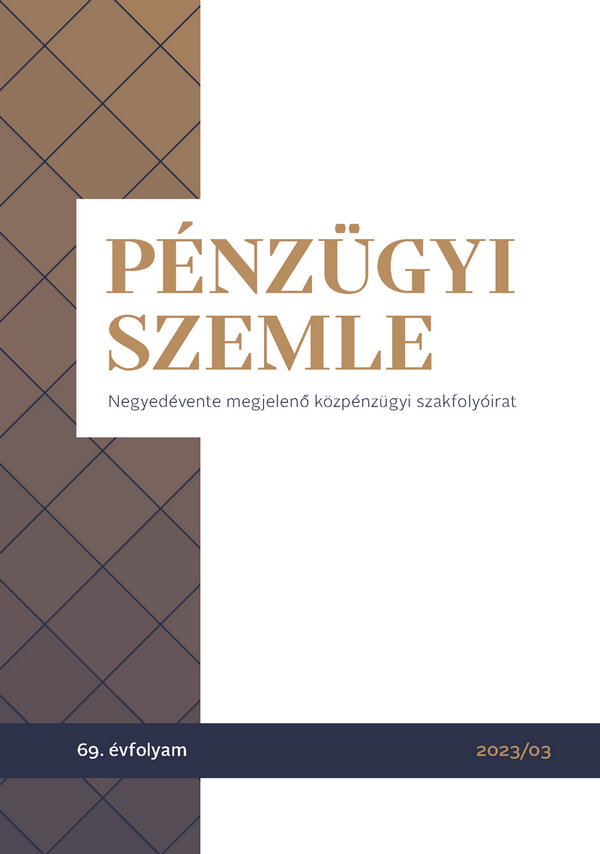A stagflation-proof bill of exchange circulation model – Presentation and evaluation
DOI:
https://doi.org/10.35551/PFQ_2023_3_6Keywords:
liquidity creation, public debt, quantity theory of money and credit, inflation, G18, G21, G32, H63Abstract
As a continuation of a preceding article discussing liquidity creation based on promissory notes and bills of exchange, the present study introduces how the use of notes and bills can foster the particular economic sectors and public debt management at a time. A financial policy package of measures first suggested by Lautenbach then introduced by Schacht fought off recession and inflation within half a decade in the German economy. We make up for a professional hiatus in the Hungarian economic literature, in that we provide a detailed evaluation of the financial solution of Schacht which has appeared in many forms in the international literature..
The then used economic model is worth considering under current economic conditions, especially if combined with Fintech methods. Suggestions for potential applications taking into consideration stagflation and endogenous growth are the following: they (1) can stop and turn recession to growth, (2) do not require external financing, (3) mitigate the burden of public debt financing, (4) have an inflation moderating effect, (5) are worth implementing in, among others, sectors such as energy, environmental protection, agriculture, wholesale and retail trade, social protection.
References
Ábel István (2019). Pénz és kamat: A monetáris politika megújítása. Prosperitas monográfiák. Budapesti Gazdasági Egyetem, Online: http://publikaciotar.repozitorium.uni-bge.hu/id/eprint/1106
Abt, P. (2017). The Nazi Fiscal Cliff: Unsustainable Financial Practices before World War II. The Gettysburg Historical Journal, Vol. 16(5). Online: https://cupola.gettysburg.edu/ghj/vol16/iss1/5
Bofinger, P. (2016). German macroeconomics: the long shadow of Walter Eucken. Megjelent: Bratsiotis, G., Cobham, D. (szerk.): German macro: how it’s different and why that matters. European Policy Centre
Bossone, B., Labini, S. (2016). “Macroeconomics in Germany: The forgotten lesson of Hjalmar Schacht.” VOX EU CEPR, July 1. Online: https://voxeu.org/article/macroeconomics-germany-forgotten-lesson-hjalmar-schacht
Botos Katalin (2016). Pénzelméleti kihívások a modern gazdaságban. In: Társadalmi és gazdasági folyamatok elemzésének kérdései a XXI. században. pp 11-22. https://doi.org/10.14232/tgfek21sz.1
Decker, F., Goodhart, C. A. E. (2021). Wilhelm Lautenbach’s credit mechanics – a precursor to the current money supply debate. EUROPEAN JOURNAL OF THE HISTORY OF ECONOMIC THOUGHT, pp 1-25. doi: 10.1080/09672567.2021.1963796.
DeBrock, M., James, H. (2019). Germany in the interbellum: camouflaging sovereign debt, in: DABLA-NORRIS, E. ed. (2019). Debt and Entanglements Between the Wars. pp 205–239. Washington, International Monetary Fund,
Feld, L. P., Koehler, E. A. & Nientiedt, D. (2021). The German Anti-Keynes? On Walter Eucken’s Macroeconomics. JOURNAL OF THE HISTORY OF ECONOMIC THOUGHT, 43(4), pp 548–563. doi: 10.1017/S1053837220000279.
Financial Stability Board (FSB) (2017). Assessment of shadow banking activities: risks and the adequacy of post-crisis policy tools to address financial stability concerns. Online: https://www.fsb.org/wp-content/uploads/P300617-1.pdf
Giatrakis, E. (2012). Employment, the Keynesian Theory and the Phenomenon of Nazism. International Journal of Humanities and Social Sciences, 2(13). pp 257-266. Online: http://www.ijhssnet.com/journals/Vol_2_No_13_July_2012/29.pdf
Juhász Katalin (2022). Zöld fordulat szükségessége az elméletben és a gyakorlatban – Erőforrásaink tegnap, ma és holnap. In: Baksay, G., Matolcsy, Gy., & Virág, B. (eds.) (2022): Új fenntartható közgazdaságtan – globális vitairat. Magyar Nemzeti Bank. pp113-122.
Kern, A., Seddon, J. (2020). The Political Economy of Independent Central Banks. Working paper prepared. for the American Political Association’s Annual Meeting 2020. http://dx.doi.org/10.2139/ssrn.3687144
Lautenbach, W. (1952). Zins, Kredit und Produktion, Tübingen, J. C. B. Mohr, XIV 220 o., Bulletin de l’Institut de recherches économiques et sociales; 19(01), 93 p. ISSN 1373-9719. doi: 10.1017/s1373971900100617.
Matolcsy György (2023). Az idő mintázatai. Az 1940-es és az 1970-es évek újraélése. Pallas Athéné Könyvkiadó Kft, ISBN: 9789635731695
Mayer, T., Schnabl, G. (2021). How to Escape from the Debt Trap: Lessons from the Past. CESifo Working Papers, No. 9078. Online: https://papers.ssrn.com/sol3/papers.cfm?abstract_id=3848340
MNB (2019). Versenyképességi program 330 pontban. Online: https://www.mnb.hu/letoltes/versenykepessegi program.pdf
MNB (2021) (eds.: Banai, Á., Nagy, B.). Egy új kor hajnalán – Pénz a XXI. században. A Magyar Nemzeti Bank tanulmánykötete a digitális jegybankpénzről. Online: https://www.mnb.hu/kiadvanyok/mnb-szakkonyvsorozat/egy-ujkor-hajnalan-penz-a-21-szazadban
Pentzlin, H. (1980). Hjalmar Schacht: Leben und Wirken einer umstrittenen Persönlichkeit. Ullstein Verlag
Pogány Ágnes (2019). Kiútkeresés a világgazdasági válságból, a költségvetési politika szerepe a harmincas évek válságkezelésében. In: Eszmék – történetek – elméletek. Tanulmányok Madarász Aladár tiszteletére. MTA KRTK Közgazdaságtudományi Intézet, Budapest, pp 196-212. Online: http://unipub.lib.uni-corvinus.hu/4067/1/Madarasz-70p196.pdf
Preparata, G. (2002). Hitler’s money. The Bills of Exchange of Schacht and Rearmament in the Third Reich. American Review of Political Economy, 1(1). pp 15-27. Online: http://www.arpejournal.com
Ritschl, A. (2001). Deficit Spending in the Nazi Recovery, 1933–1938: A Critical Reassessment. Zurich IEER Working Paper No. 68, http://dx.doi.org/10.2139/ssrn.259264
Ritschl, A. (2012). Reparations, Deficits, and Debt Default: The Great Depression in Germany. London School of Economics. Economic History Department Working Papers, No. 163/12. a chapter prepared for: Crafts, N., Fearon, P. (eds.) (2013). The Great Depression of the 1930s: Lessons for Today, Oxford: Oxford University Press. DOI:10.1093/acprof:oso/9780199663187.001.0001
Roselli, A. (2014). Money and Trade Wars in Interwar Europe. The Palgrave Macmillan
Schacht, H. (1967). The Magic of Money. Oldbourne, London.
Stucken, R. (1953). Deutsche Geld- und Kreditpolitik. 2. Auflage. Tübingen, J.C.B. Mohr (Paul Siebeck), VI. p. 271 o., In: Bulletin de l’Institut de recherches économiques et sociales, 20(01), pp 128-129.; ISSN 1373-9719; Cambridge University Press- https://doi.org/10.1017/s1373971900103993
Szalay Zsuzsanna, Vértesy László & Novák Zsuzsanna (2020). A kis-és középvállalkozási szektor erősítése váltóra váltással. Pénzügyi Szemle/Public Finance Quarterly, 65(3). pp 413-429. https://doi.org/10.35551/PSZ_2020_3_6
Szalay Zsuzsanna, Novák Zsuzsanna & Szathmáry Géza (2022). Váltó alapú likviditásteremtés. KÖZGAZDASÁGI SZEMLE, (Creating liquidity with bills of exchange) 69(9). pp 1091-1047. http://doi.org/10.18414/KSZ.2022.9.1031
Vigvári Gábor (2003). Nemzetiszocialista keynesiánusok? Fordulat, tavasz. pp 61-72.
Werner, R. A. (2005). New Paradigm in Macroeconomics. Solving the Riddle of Japanese Macroeconomic Performance. New York: Palgrave Macmillan.
Werner, R. A. (2014). Enhanced Debt Management: Solving the eurozone crisis by linking debt management with fiscal and monetary policy. Journal of International Money and Finance, 49, pp 443-469. https://doi.org/10.1016/j.jimonfin.2014.06.007
Downloads
Published
How to Cite
Issue
Section
License
Authors assign copyright to Pénzügyi Szemle / Public Finance Quarterly. Authors are responsible for permission to reproduce copyright material from other sources.












